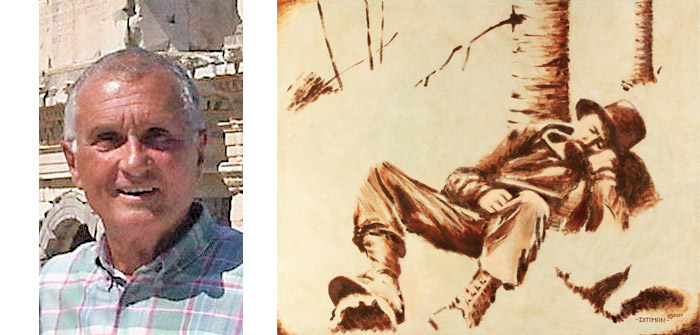((L) Dave Dittman (R) Pioneer in Repose)
Central Oregon-based artist Dave Dittman is testament to the fact that it is never too late to pursue something that you love. A long career in political polling and some time in the military took Dittman’s attention away from art for nearly 50 years, but he’s taken up his brush again in retirement, this time focusing on oil paintings of historical people.
“I remember when I was young, my mom had a notepad by the phone for taking notes, and she would occasionally be annoyed to find tanks drawn on her once clean pages,” Dittman said. His art has always come from a place of genuine interest, which is reflected by his first drawings: Sherman tanks, fighter planes, B17 bombers and more military equipment that many young boys born at the beginning of WW2 are drawn to. He recalls receiving support from his parents and teachers, and those compliments pushed him to draw even more. “It created a positive-feedback loop in my mind,” he said. As a child he began sketching figures, and since then his work has focused on the human form in some way.
College took Dittman in another direction, as political polling was becoming more prevalent in society, and he was enamored by the study and application of huge statistics. He would attend Brigham Young University and graduate in 1966 with a bachelor of science degree in Statistics, Accounting, Economics and Art.
After college, Dittman joined the Army and was stationed in Alaska where he would eventually become the Commanding Officer of the U.S. Army Advanced Marksmanship Unit, and leader of the Army Mountain Rescue Team, summiting Mt. Denali along the way. In Alaska, Dittman met his wife, Terry (who he has been married to now for 54 years) and started having children. While he still wanted to pursue art and even got commissioned to paint family portraits of high-level military families, he knew Alaska just didn’t have a large enough population to create demand for his work.
Dittman spent the next 50 years running a political consulting and communications business, raising kids and growing with his family. Over that time, he won 11 Pollies, which were the political equivalent to an Emmy. In 2015, Dittman and his wife sold the business and moved to Sunriver to be closer to their grandkids. This is where Dittman’s life as an artist blossomed.
After the move, Dittman found interest in Pioneer-era figures and stories. Alaska and Oregon share a wild landscape, one that was explored by everyday people who we know as pioneers, and Dittman now finds himself interested in the inner-workings of these people’s minds. His newest collection, Along The Oregon Trail, is a collection of 12 oil paintings that share a common theme. Other than Dittman’s use of sepia tones, his avoidance of color and his love of intense shadows and light, his paintings all tell a story about the thoughts and emotions of the fictional people he portrays.
“These people might be fictional, but real people did go through what they went through,” Dittman said, when referencing the scenes in his work, which include a pioneer woman mourning outside a fresh grave, a springboard logger catching some precarious sleep high in a Pacific forest canopy, and two kids taking a rest after becoming orphans on the Oregon Trail.
Each one of the paintings is accompanied by a short narrative that Dittman writes to help explain what each figure might be thinking, signified by the fact that each figure has closed eyes and an expression of deep thought. From undiagnosed mental health issues to a “I have nothing to lose” attitude that helped people press forward, Dittman’s work explores the humanity behind the historic figures that can often be viewed as stiff and distant. “These were real people just like you and me who risked everything for a new life. They must have been thinking ‘Am I really doing this?’ at some point along their journey,” Dittman said.
When asked about his motivations, Dittman provided a refreshing answer. “I don’t really have an artist’s statement in the same way many artists do. I don’t have any prolific or deep reason to be doing things, and I don’t think you need something like that to do what you love. Like ancient cave paintings and hand prints, sometimes humans just do things because it brings them and the people around them joy. I enjoy my art, I enjoy telling the stories I do, and I love to see the smiles on people’s faces when I gift them a piece of art. I always think, ‘Isn’t that all the motivation that should matter?’”
You can find Dittman’s art at various locations through the Sisters Art Association, as well as his website.

